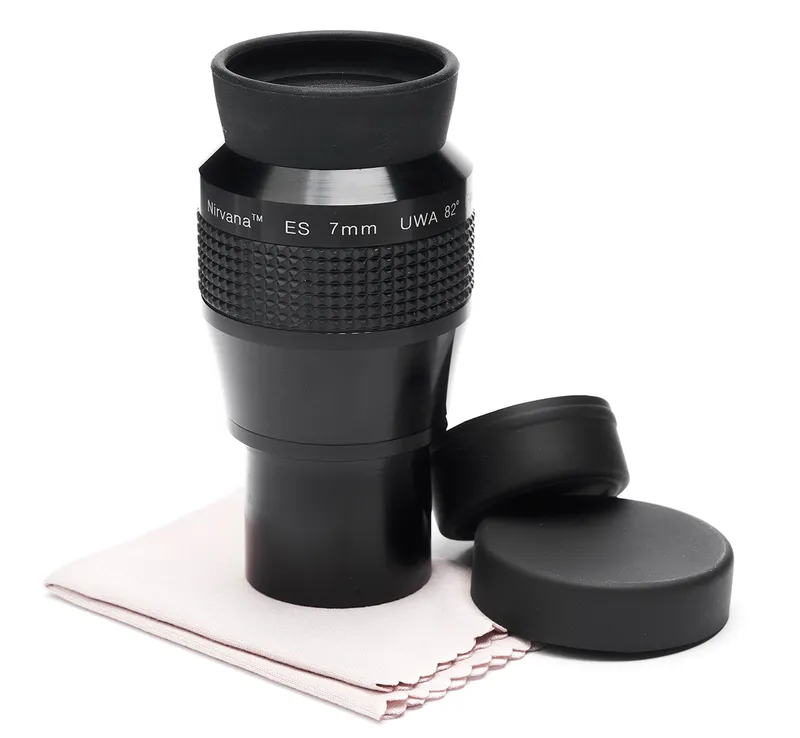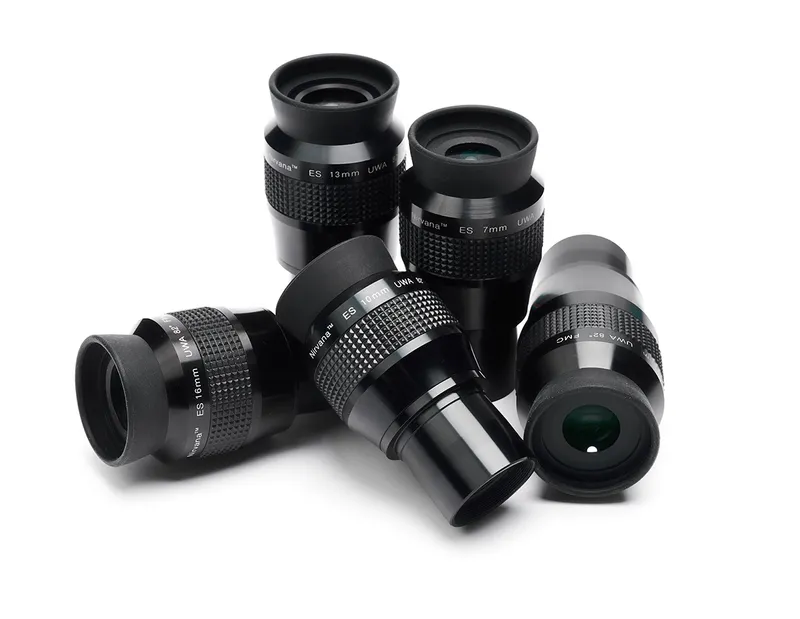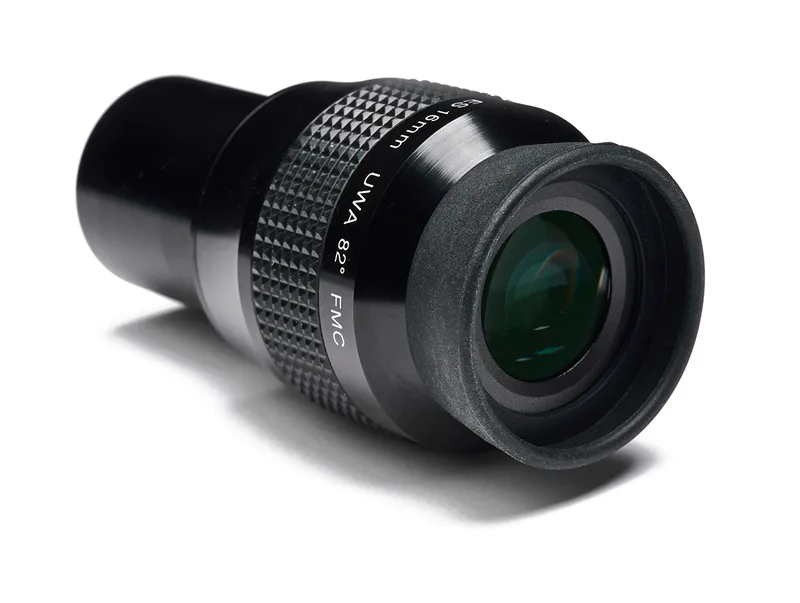Recently mechanically redesigned, Nirvana-ES UWA-82° eyepieces now have two more focal lengths added to the stable, bringing the set up to five.
These range in focal length from 4mm to 16mm.
The eyepieces all have a 1.25-inch-diameter barrel (threaded for filters), so will fit most common astronomical telescopes.
We tested them using a 90mm f/13.9 Gregory-Maksutov telescope and a 130mm f/5 Newtonian telescope.
Read our beginners' guide to eyepieces

The whole set is specified to be parfocal, so little or no refocusing should be necessary when you change eyepieces.
In practice, the 16mm and 13mm are parfocal with one another, as are the 10mm, 7mm and 4mm.
They all have an apparent field of view of 82°, which means that the diameter of the eyepieces’ field stop as seen through the eyepiece subtends an angle of 82° at your pupil.
This angle includes a significant amount of your peripheral vision, so you need to ‘look around’ the field of view if you want to see detail in any specific part of it.
This is because the part of your field of view in which you can discern useful visual information is only about 35° wide.

How to use an ultra-wide eyepiece
If you’re new to ultra-wide eyepieces, it’s worth mentioning the viewing technique to use.
Approach the eyepiece with your viewing eye, stopping as soon as you can see the entire field of view in your peripheral vision.
Your pupil is now at the eyepiece’s exit pupil.
If you move your eye to view parts of the field of view away from the centre, you will move your pupil away from the exit pupil, leading to ‘kidney-bean’ blackouts in your vision.
Instead, you should ‘roll’ your head, ensuring that your pupil remains in the same place as you scan across the field of view.

How the Nirvana UWA-82˚ eyepieces performed
The summer sky precluded testing the eyepieces on very faint objects, but initial testing on star clusters showed them to be sharp, with good contrast and colour fidelity.
We took advantage of an 8-day-old Moon in unusually steady seeing to compare the eyepieces.
Beginning with the 16mm and the Maksutov scope, we noted that the entire lunar surface was visible with space to spare, giving time to appreciate the view as the Moon slowly drifted across it.
We got very crisp views with this eyepiece, but possibly some softening of the image near the edge of the field of view.
With the Newtonian, the view was crisp in the central 75%, but the edge softness was more apparent.
Turning to the 13mm, with the Maksutov we found a similar view to the 16mm, with slightly more detail revealed.
We couldn’t discern any edge-softening.
However, in the Newtonian the edge-softening was more visible.

We swapped to the 10mm in the Maksutov, and wow!
Detail along the terminator really began to pop, and in the Newtonian the craterlets in Ptolemaeus looked good.
With this eyepiece, edge-softening was not detectable.
Changing to the 7mm in the Maksutov, we saw a beautifully crisp image, and lunar sunrise along the terminator was mesmerising.
We saw sublime shadow-play in crater Arzachel and the central peak of Alphonsus casting a sharp, pencil-thin shadow to the crater’s edge.
In the Newtonian, the shorter focal length didn’t compromise the 7mm, with lovely, sharp detail everywhere. A gorgeous eyepiece!
Finally, we turned to using the 4mm. In the Maksutov, this provided too much magnification (313x) even with steady seeing.
However, with the Newtonian (163x) there were crisp, detailed views but distinctly less contrast than the 7mm in the Maksutov.
We noted glare when the Moon was just outside the field of view, which was not present in the other eyepieces, suggesting an unblackened lens edge might be the culprit.
In general, these are good-value eyepieces, but note that there is insufficient eye relief to enable the full field of view to be visible if you wear spectacles.
Also, the 2.5mm lettering makes it difficult to see the printed focal length in dim light.
If you’re seeking a significant step-up from eyepieces that come bundled with a telescope, you will appreciate the Nirvanas.
And if you only want one, make it the 7mm!

Seven lens elements
The Nirvana-ES UWA-82° eyepiece set includes features that are usually only found in high-end eyepieces.
Optical aberrations tend to become more pronounced with wider fields of view.
Eyepiece designers mitigate this by introducing additional lens elements to reduce or eliminate these aberrations.
The Nirvana UWAs have seven lens elements.
Every additional piece of glass will absorb or reflect some light, so it is essential to reduce this loss of brightness.
This is achieved by applying an anti-reflective multi-coating to every interface between air and glass.
If you look into the base of the eyepiece, you’ll notice that there are baffles on the inside of the barrel.
These eliminate image-degrading, spurious reflections off the barrel walls, helping to add contrast to the image that you see.
What you cannot see is that (with the exception of the 4mm’s field lens), the edges of the lenses are blackened.
Lens edges are potentially a source of glare, so blackening the edges with low-reflectivity black paint will reduce the likelihood that you will be plagued by this effect.
5 best features
Excellent ergonomics
The mechanical redesign of these eyepieces has resulted in the centre of gravity of all of them now being where the knurled rubber grip is located. There is therefore no sense of lopsided weight distribution when you pick them up or remove them from the telescope.
Soft rubber eye-cups
Eye placement is critical in ultra-wide-angle eyepiece designs; the soft rubber eyecups help with this. We found that the ideal eye position was just short of touching the eyecup, so the soft rubber gives you a gentle reminder if you get too close.
Similar weights
The specified weight is 170g and, despite their different sizes, all the eyepieces have a weight within 3 per cent of this (165–172g). As a consequence, there is no need to rebalance the telescope in its mount when you change eyepieces during an observing session.
Tapered undercut
The eyepiece barrel has a slightly tapered undercut. This will not only prevent the eyepiece from falling out if the eyepiece holder isn’t fully tightened, but will also tend to pull the eyepiece fully into the holder as it is tightened, which is a useful trait for parfocal eyepiece sets.
Dust prevention
The eyepieces have caps for both ends to keep dust at bay and each eyepiece is provided with a microfibre cleaning cloth. Soft microfibre, which is even finer than silk, is the preferred material for cleaning optics so, if the lenses do get dirty, you have the means to clean them.
Vital stats
- Price: £95, £95, £85, £85, £85
- Focal lengths: 16mm, 13mm, 10mm, 7mm, 4mm
- Apparent field of view: 82°
- Eye relief: 12mm
- Optical elements: 7
- Barrel size: 1.25mm
- Extras: Dust caps, microfibre cloth
- Weight: 170g each
- Supplier: Optical Vision Ltd
- Email: info@opticalvision.co.uk
- www.opticalvision.co.uk
This review appeared in the September 2023 issue of BBC Sky at Night Magazine.

